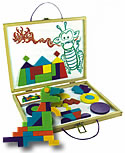Topics
Bilateral motor coordination
ball skills
calming
cooperative games
crossing midline
cutting
dyspraxia
fine motor coordination
gross motor
group activities
handwriting
in-hand manipulation
inside activities
messy play
motor planning
obstacle course
pencil use
preschool
recess
sensory
sensory processing
shoetying
story starters
strengthening
tactile
upper body strength
vestibular; balance
visual motor skills
writing
Barrier Games develop organization, direction following & giving
Directions: Giving & Following in a Cooperative Game
Robot-Programmer Game:
There are 3 levels of play, but set-up is the same for each. Create, at least 6 locations and place matching treasures at each so you can tell that teams have been at each location. (Maybe #1 has all bean bags/#2 all plastic eggs/#3 wood blocks/#4 paper balls/#5 pencils/ #6 plastic cups etc). You need 1 more location than there are teams. Players work in teams of 2 or 3. Player 1 is the robot, who can only follow orders given and the others are programmers in charge of the code/directions. Have each team sit on a rug square or other floor marker as their "home". Place chairs and other obstacles throughout the play area. Programmers must navigate their Robots to a location, collect a treasure and return it home, before navigating to another treasure.
Rules:
- Robots can only walk in a straight line.
- Turns can only be right or left. So to turn completely around 2 commands are needed.
- Turns commands do not include any steps forward.
- "Pick up a treasure" or "Put down treasure" needs to be a command.
- The number of steps to be taken can be given in 1 command (Forward 3 steps)
- Robots STOP when they are about to bump into an object or another robot.
Basic Version: Programmers follow their robot and give commands verbally as they go.
Standard Version: Programmers draw arrows & numbers on small pieces of paper that the robot follows. Several papers may be given at once, but they must be followed in the order presented.
Advanced Version: Programmers draw arrows & numbers on a single paper. The robot follows the directions; must start again if changes are needed to the program, which can be made on the same paper as needed.
Subscribe to:
Posts (Atom)

